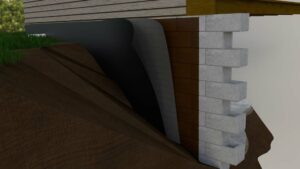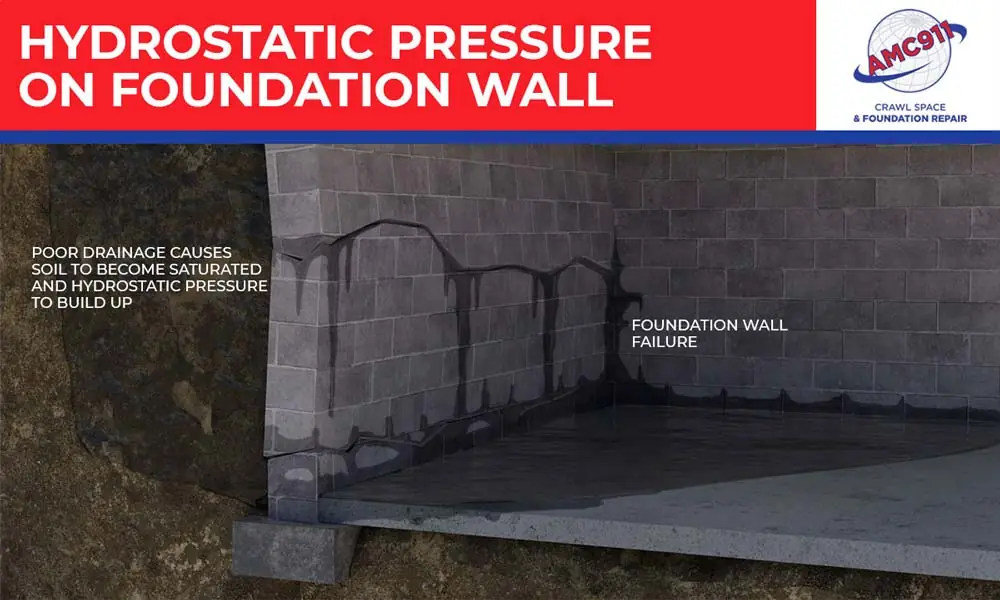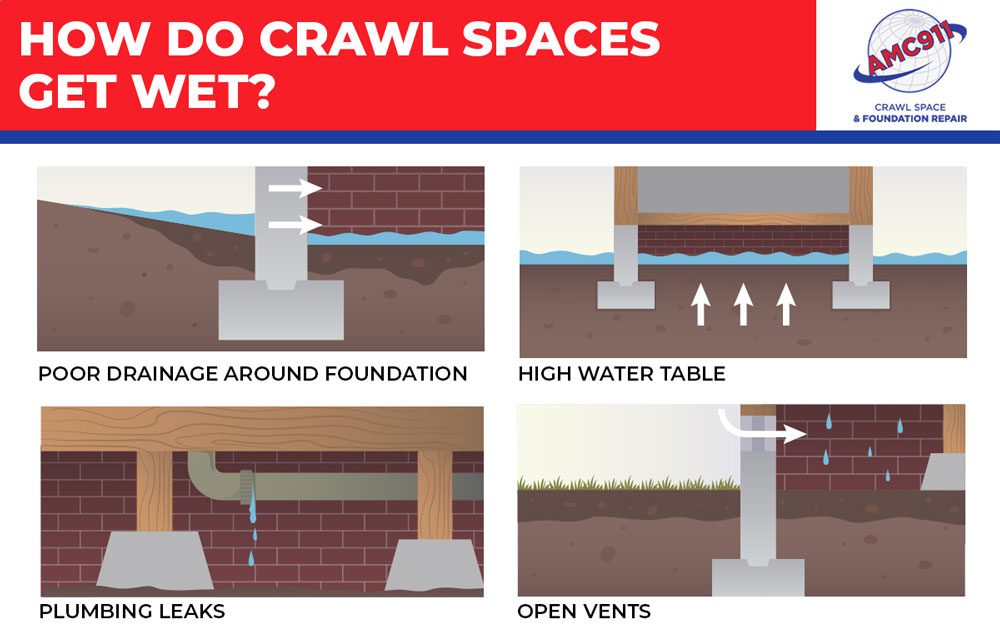Looking for information about exterior waterproofing? If so, then you’re in luck because we are the waterproofing experts. In this article, we’ll review exterior waterproofing, why your home’s foundation might need waterproofing, how crawl spaces and basements get wet, how exterior waterproofing is done, and more.
What Is Exterior Waterproofing?
Exterior foundation waterproofing involves applying a waterproof coating or membrane to the exterior walls of a building’s foundation and then possibly installing a drain tile system as well.

The coating or membrane prevents water penetration through the foundation wall, and the drain tile system prevents moisture from building up in the soil around the foundation.
Exterior foundation waterproofing is essential for any building located in an area with a high groundwater table, heavy rainfall, or at risk of flooding.
Why Waterproof A Foundation?
Believe it or not, most foundation problems are caused by water. Therefore, waterproofing your foundation is essential in protecting your home’s structural integrity. This is particularly important in regions with heavy rainfall or high groundwater levels, which can lead to soil saturation and cause hydrostatic pressure to build up and push against your foundation. Damp walls and floors can also cause mold growth, which can cause allergic reactions and respiratory problems for anyone living in the home.
What Is Hydrostatic Pressure, and How Does It Affect a Foundation?
When groundwater can’t move freely through the soil because of poor drainage, hydrostatic pressure can build up and exert significant pressure on the foundation walls and slab, causing them to move, crack, or bow inward. This can lead to serious issues such as basement flooding, wall and floor damage, or even foundation failure.

How Do Crawl Spaces and Basements Get Wet?
There are various ways water can infiltrate a crawl space or basement, including the following:
- Through cracks – Hydrostatic pressure is powerful enough to push water through invisible cracks in a foundation wall and into your crawl space or basement. Hydrostatic pressure can even cause a foundation wall to crack. This problem is exacerbated during heavy rainfall, and in areas like Hampton Roads where the water table is high.
- Through open vents or windows – Open crawl space vents (or windows in a basement) allow warm, humid air to come into contact with cooler surfaces, resulting in condensation.
- Plumbing leaks – Plumbing leaks and malfunctioning appliances such as washing machines, water heaters, and sump pumps can also cause water damage in crawl spaces and basements. Even small leaks can lead to extensive damage over time if left unchecked.
- High groundwater table – This can create soggy soil in a crawl space.
- Poor drainage around the foundation – All that water has to go somewhere, right? If it can’t drain off, it will find a way into your crawl space or basement.

Why Exterior Waterproofing?
When it comes to waterproofing a foundation, there are two main options: exterior and interior waterproofing. While both methods protect your home from water damage, there are some differences between the two.
Exterior foundation waterproofing involves excavating the soil around the perimeter of the foundation down to the footing and applying a waterproof membrane or coating to the exterior walls. While this method is very effective at preventing water from entering the foundation wall in the first place, it’s more expensive to perform on an existing foundation because it requires excavation.
While interior waterproofing is less expensive and still very effective at keeping water out of a basement or crawl space, it doesn’t stop water from coming into contact with the foundation wall as with exterior waterproofing.
In terms of cost, exterior foundation waterproofing tends to be more expensive than interior waterproofing due to the excavation required. However, the long-term benefits and reduced maintenance costs make it an excellent investment in ensuring your home’s structural integrity.
How Is Exterior Waterproofing Performed?
- Excavation to access the exterior foundation walls – Excavation is the first step in exterior waterproofing. The soil around the building is excavated to expose the foundation walls, where the waterproofing material will be applied.
- The foundation walls are cleaned – Once the foundation walls are exposed, the surface is cleaned to remove any dirt and debris. This is followed by a thorough inspection of the foundation walls. If there are any cracks, they must be repaired before the waterproofing material is applied.
- Waterproofing material is applied to the foundation wall – The waterproofing material, typically a liquid or a sheet membrane, is then applied to the foundation walls.
- A drain tile system might also be installed – A drain tile system collects excess groundwater and directs it away from the foundation before release. This is an excellent way to ensure good drainage around the foundation.
Signs You Might Need Exterior Waterproofing
Signs that indicate your home might need exterior waterproofing include the following:
- Wet crawl space or basement – This could be a sign water is seeping into the area through the foundation wall or the crawl space’s dirt floor.
- Water stains on walls – Water stains on foundation walls suggest water is penetrating through tiny cracks.
- Mold growth – The presence of mold means there’s excess moisture in the area.
- Visible cracks in the foundation wall – These cracks could have been caused by hydrostatic pressure pushing against the wall. If so, exterior waterproofing and a drain tile system may be the correct solution.
If you think your home’s foundation might need exterior waterproofing, contact us today to schedule a free evaluation. Let us protect your home from its worst enemy… water.















